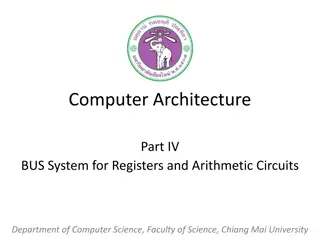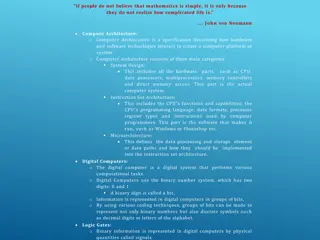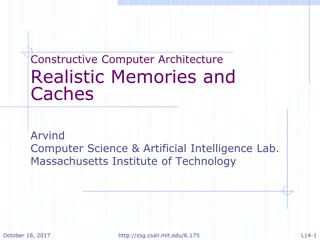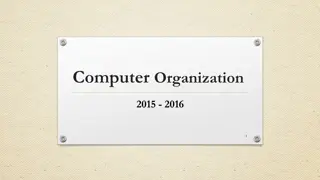Understanding MARIE: A Simple Computer Architecture
Explore the MARIE architecture through components like registers and buses, learning about binary representation, instruction set, and data movement. Understand how MARIE simplifies the understanding of computer functions, following Leonardo Da Vinci's advice to keep it intuitive and easy. Discover the seven registers of MARIE and how they facilitate data processing and control in this beginner-friendly introduction to computer architecture.
Download Presentation

Please find below an Image/Link to download the presentation.
The content on the website is provided AS IS for your information and personal use only. It may not be sold, licensed, or shared on other websites without obtaining consent from the author. Download presentation by click this link. If you encounter any issues during the download, it is possible that the publisher has removed the file from their server.
E N D
Presentation Transcript
MARIE: An Introduction to a Simple Computer
Lecture Overview MARIE Introduction The Architecture Registers and Buses The Instruction Set Architecture Register Transfer Notation Instruction processing 2
MARIE MARIE Introduction (1/1) We are now familiar with computer components but how these are connected together? How these work together? Leonardo Da Vinci once said: When you wish to produce a result by means of an instrument, do not allow yourself to complicate it In this part we will use a MARIE, A Machine Architecture that is Really Intuitive and Easy. MARIE will help us to understand how computer functions (even the more complex computers) 3
MARIE The Architecture (1/1) The MARIE architecture has the following characteristics: Binary, two's complement data representation. Stored program, fixed word length data and instructions. 4K x 16 word-addressable main memory. 16-bit instructions: 4 bits for the opcode, 12 bits for the address. A 16-bit arithmetic logic unit (ALU). Seven registers for control and data movement. 4
MARIE Registers and Buses (1/5) MARIE s seven registers are: AC: Accumulator, a 16-bit register that holds a conditional operator (e.g., "less than") or one operand of a two-operand instruction. MAR: Memory address register, a 12-bit register that holds the memory address of an instruction or an operand of an instruction. MBR: Memory buffer register, a 16-bit register that holds the data after its retrieval from, or before its placement in memory. 5
MARIE Registers and Buses (2/5) MARIE s seven registers are: PC: Program counter, a 12-bit register that holds the address of the next program instruction to be executed. IR: Instruction register, a 16-bit register that holds an instruction immediately preceding its execution. InREG: Input register, an 8-bit register that holds data read from an input device. OutREG: Output register, an 8-bit register that holds data that is ready for the output device. 6
MARIE Registers and Buses (3/5) The MARIE architecture is shown in the figure below: 7
MARIE Registers and Buses (4/5) MARIE cannot transfer data or instructions into or out of registers without a bus. In MARIE, we assume a common bus scheme Each device on the bus is identified by a unique number. If the device is required to use the common bus, Its number is set on the control lines. Some direct pathways (without using the common bus) are also available to speed up execution MAR Memory ; AC ALU ; AC MBR ; MBR ALU. 8
MARIE Registers and Buses (5/5) The Data path in MARIE is shown in this figure Note that a data word (that is an instruction) in the main memory travels a relatively long path before achieving the IR! 9
Lecture Overview Introduction MARIE Introduction The Architecture Registers and Buses The Instruction Set Architecture Register Transfer Notation Instruction processing 10
MARIE The Instruction Set Architecture (1/7) MARIE has a very simple, yet powerful, instruction set. The Instruction Set Architecture (ISA) specifies the format of its instructions and the primitive operations that the machine can perform. The ISA is an interface between a computer s hardware and its software. Some ISAs include hundreds of different instructions for processing data and controlling program execution. 11
MARIE The Instruction Set Architecture (2/7) For MARIE, each instruction consists of 16 bits These bits are organized as follows: Opcode: 4 bits (bits 12 to 15), specifies the instruction to be executed (which allows for a total of 24=16 instructions, but only 13 are used) Address: 12-bits (bits 0 to 11), forms an address. An instruction word 12
MARIE The Instruction Set Architecture (3/7) The fundamental MARIE instructions are: 13
MARIE The Instruction Set Architecture (4/7) Example: Consider the following binary instruction: 0001000000000011. What is the job of this instruction? Solution: The first four MSB forms the opcode 0001 . It corresponds to a LOAD instruction. The remaining 12 bits indicate the address of the value we are loading, which is address 3 in main memory. This instruction causes the data value found in main memory, address 3, to be copied into the AC 14
MARIE The Instruction Set Architecture (5/7) One important instruction is SKIPCOND When the Skipcond instruction is executed, the value stored in the AC must be inspected. The next instruction is skipped (resp. not skipped), if the condition tested is True (resp. False). Bits 11 and 10 (say b11b10) in the AC specify the condition to be tested, if: - b11b10 = 00: The CPU tests if AC < 0 - b11b10 = 01: The CPU tests if AC = 0 - b11b10 = 10: The CPU tests if AC > 0 15
MARIE The Instruction Set Architecture (6/7) Example: Consider the following binary instruction: 1000100000000000. What is the job of this instruction? Solution: The opcode 1000 corresponds to a skipcond b11b10= 10, so the instructions job is to skip the next instruction if AC > 0. 16
MARIE The Instruction Set Architecture (7/7) In general we use: SKIPCOND 000 which means skip the next instruction if the AC <0. SKIPCOND 400 which means skip the next instruction if the AC =0. SKIPCOND 800 which means skip the next instruction if the AC >0. Note that 000, 400 and 800 are in base 16, They are equivalent to 12bits (Address part)! 17
Lecture Overview Introduction MARIE Introduction The Architecture Registers and Buses The Instruction Set Architecture Register Transfer Notation Instruction processing 18
MARIE Register Transfer Notation (1/7) MARIE instruction appears to be very simplistic Actually, at the component level, each instruction involves multiple operations called microoperations Register Transfer Language (RTL),or Register Transfer Notation (RTN) specifies the exact sequence of microoperations that are carried out by an instruction. 19
MARIE Register Transfer Notation (2/7) In the MARIE RTL we will use the following : M[X]: to indicate the actual data value stored in memory location X : to indicate the transfer of bytes to a register or memory location In the following few slides we will present the RTL for each of the instructions in the ISA for MARIE 20
MARIE Register Transfer Notation (3/7) Load X MAR X (loads the contents of memory location X into the AC) Place the address X in MAR; MBR M[MAR] AC MBR Store X (stores the contents of AC into the memory location X) MAR X MBR AC M[MAR] MBR The data M[MAR] at location address MAR is moved into the MBR; The content of MBR is placed in the AC. Place the address X in MAR; Place the content of AC in MBR Place the content of MBR in the memory location MAR (M[MAR] is replaced by MBR) 21
MARIE Register Transfer Notation (4/7) Add X MAR X MBR M[MAR] AC AC + MBR Subt X MAR X MBR M[MAR] AC AC - MBR (The data value stored at address X is added to the AC). Place the address X in MAR; Place the data M[MAR] at location address MAR in MBR; Place the sum AC + MBR in AC (The data value stored at address X is subtracted from AC). Place the address X in MAR; Place the data M[MAR] at location address MAR in MBR; Place AC - MBR in AC 22
MARIE Register Transfer Notation (5/7) Input AC InREG Output OutREG AC Halt no need for any RTL! Jump X PC X (Inputs a value from the keyboard into AC) Place the content of InREG (contains the input) in the AC. (Output the value in AC to the display) Place the content of AC (contains the output) in the OutREG (to sent data to the display) (Terminate the program) (unconditional branch to the given address, X) Load X into the PC 23
MARIE Register Transfer Notation (6/7) Skipcond if IR[11 10] = 00 then if AC < 0 then PC PC+1 else if IR[11 10] = 01 then if AC = 0 then PC PC + 1 else if IR[11 10] = 10 then if AC > 0 then PC PC + 1 {if bits 10 and 11 in the IR are both 0} {if bit 11 = 0 and bit 10 = 1} {if bit 11 = 1 and bit 10 = 0} 24
MARIE Register Transfer Notation (7/7) Important Notes Any instruction is firstly placed into the instruction register IR where: - IR[15-12] contains the opcode - IR[11-0] contains the operand (address) In all the previous RTL, X can be replaced by IR[11-0]! Example: - The RTL for Jump X can be written as follows: PC IR[11-0] 25
Lecture Overview Introduction MARIE Instruction processing The Fetch-Decode-Execute cycle Interrupts 26
Instruction processing The Fetch-Decode-Execute cycle (1/1) MARIE, like any other computer architecture, follow the basic machine cycle: the fetch, decode, and execute cycle Fetch Decode Execute 27
Instruction processing Interrupts (1/3) An important issue (that is not covered here for MARIE) is interrupt handling Most computers provide a way of interrupting a running program Examples of interrupts: A user break is issued (e.g., Ctrl+C) I/O is requested by the user or a program A critical error occurs Practically, when an interrupt occurs a special bit in the status register or flag register of the CPU is set. 28
Instruction processing Interrupts (2/3) The CPU checks this bit at the beginning of every machine cycle If the bit is set, the CPU processes an interrupt as follows: 1. Pause the execution of the current program 2. Run the interrupt s appropriate routine 3. Continue the execution of the previously paused program (after finishing the interrupt s routine) If the bit is not set, the CPU performs a normal new fetch, decode, execute cycle of the program currently being executed. 29
Instruction processing Interrupts (3/3) When the CPU finishes the interrupt s routine, it must return to the exact point at which it was running in the original program. Before the CPU switches to the interrupt service routine, it must save: The contents of the PC The contents of all other registers in the CPU Any status conditions that exist for the original program. 30
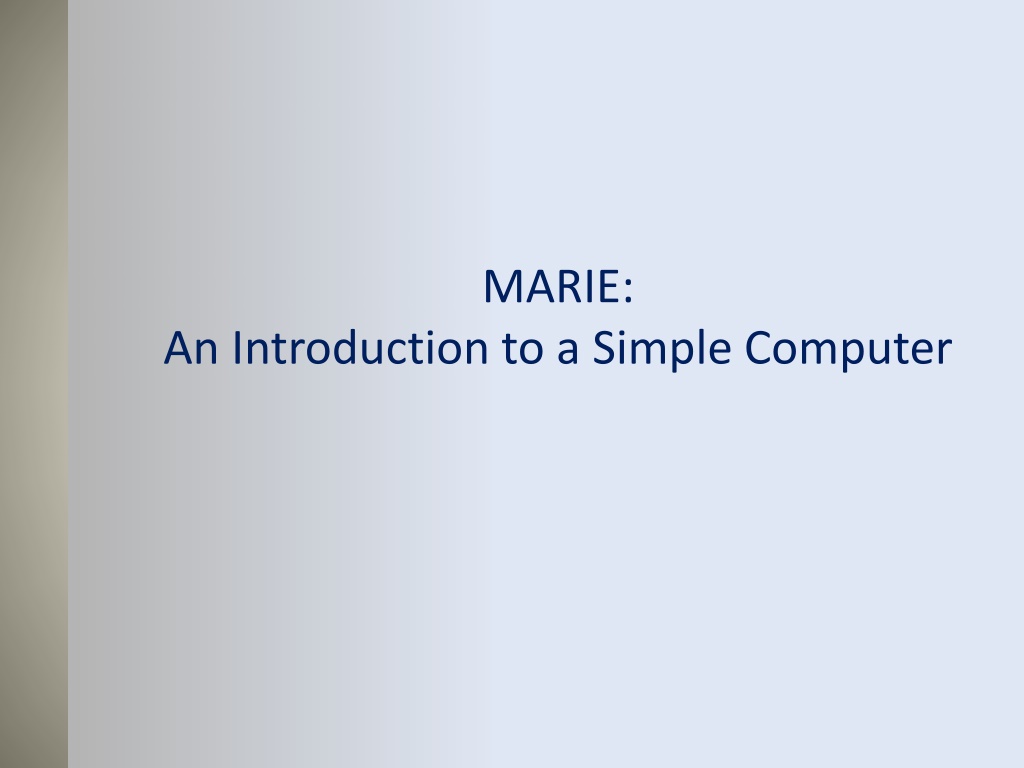

![❤Book⚡[PDF]✔ The Apollo Guidance Computer: Architecture and Operation (Springer](/thumb/21611/book-pdf-the-apollo-guidance-computer-architecture-and-operation-springer.jpg)






